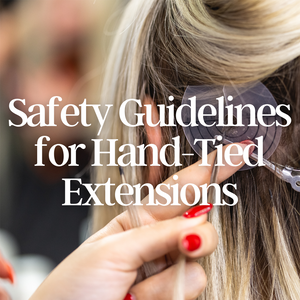Hand-tied extensions are a popular method for adding length and volume to natural hair, providing a seamless and natural look. However, the process of applying and removing these extensions is delicate and requires meticulous attention to detail to ensure the safety and comfort of the client. At Sax&Ro we prioritize the well-being of clients through every step of the application and removal processes.
Check out our safety guidelines and best practices to follow.
1. Client Consultation: Assessing Suitability
Health and Hair Assessment: Before proceeding with hand-tied extensions, conduct a thorough assessment of the client's hair health and scalp condition. Look for signs of:
- Weak, brittle, or excessively thinning hair
- Scalp issues such as psoriasis, severe dandruff, or eczema
- Allergies to materials or sensitivity to hair products
Client History and Lifestyle Consideration: Understand the client’s daily routine, as their lifestyle can impact the longevity and maintenance of the extensions. Assess their commitment to upkeep, which is crucial for preventing potential discomfort or hair damage.
2. Preparing for Application
Choosing the Right Type of Extension: Select the appropriate type of hand-tied extensions that best matches the client’s natural hair texture, density, and color. This ensures not only aesthetic harmony but also minimizes strain on natural hair, maintaining scalp health.
Hygiene and Safety: Ensure all tools and the work area are sterilized before beginning the application. Use gloves if necessary, particularly if the client has sensitivities. Keeping a clean environment helps prevent any risk of infections.
3. Application Process
Testing for Sensitivities: Conduct a patch test for any adhesives or extension materials to be used during the application process, even if the primary method involves beading or sewing. This test should be done at least 24 hours before the actual appointment to ensure the client does not have adverse reactions.
Sectioning and Placement: Proper sectioning is crucial:
- Avoid applying extensions too close to the hairline or nape to prevent visibility and discomfort.
- Ensure the sections are clean, uniform, and not too tight; this reduces tension on the scalp and prevents headaches or traction alopecia.
Applying the Wefts:
- Beads or threads used to attach the wefts should be secure but not overly tight. Excessive tension can lead to headaches and hair breakage.
- Double-check that the wefts lay flat against the scalp to avoid unnatural bulking, which can be uncomfortable and unsightly.
Final Inspection for Comfort: Ask the client for their input on how the extensions feel on their scalp. Making adjustments immediately after application is crucial to prevent long-term discomfort.
4. Client Education: Maintenance and Daily Care
Proper Brushing Techniques: Teach the client how to brush their extensions properly to avoid pulling at the roots. Recommend a soft bristle brush and demonstrate starting from the ends, moving upward to detangle gently.
Washing and Styling Tips:
- Advise the client to use sulfate-free and alcohol-free shampoos and conditioners to avoid drying out the extensions and natural hair.
- Explain how to wash their hair by gently massaging the scalp and avoiding vigorous scrubbing which can loosen the wefts.
Sleeping Arrangements: Suggest sleeping with hair in a loose braid or silk bonnet to prevent matting and tangling overnight, which can cause discomfort and pull on the scalp.
5. Removal of Hand-Tied Extensions
Scheduled Removal: Encourage clients to return to the salon for professional removal of extensions to prevent damage to their natural hair. Set a timeline for removal based on their hair growth and the lifespan of the extensions, typically 6-8 weeks.
Safe Removal Practices:
- Gently cut the threads or open the beads attaching the extensions to the natural hair.
- Use a specialized tool for bead removal to avoid pulling hair.
- Support the natural hair during removal to prevent stress and breakage.
Post-Removal Care: Provide a treatment or deep conditioning session post-removal to help restore natural hair and scalp health. Assess any damage or stress to the scalp and advise on potential rest periods before reapplying new extensions.
6. Troubleshooting Common Issues
Managing Discomfort: If a client reports pain or discomfort after application, they should be advised to contact the salon immediately. Minor adjustments can often resolve issues without requiring full removal.
Dealing with Slippage or Loosening: Regular maintenance appointments can help catch and fix slippage or loosening of wefts. Early detection prevents further strain on the hair and discomfort to the client.
Allergic Reactions: In rare cases of allergic reactions or irritation from the extensions or the products used, prompt removal and appropriate scalp treatments are necessary.
Conclusion
Ensuring the safety and comfort of clients during the application and removal of hand-tied extensions is paramount. Following these guidelines will help stylists prevent complications and provide clients with a satisfying and harm-free enhancement to their natural beauty. Sax&Ro's commitment to quality and client care exemplifies the standards to which all professional stylists should aspire, promoting a safe and enjoyable experience with hand-tied extensions. By prioritizing client health and satisfaction, stylists can build a loyal customer base that trusts their professional skills and cares.

